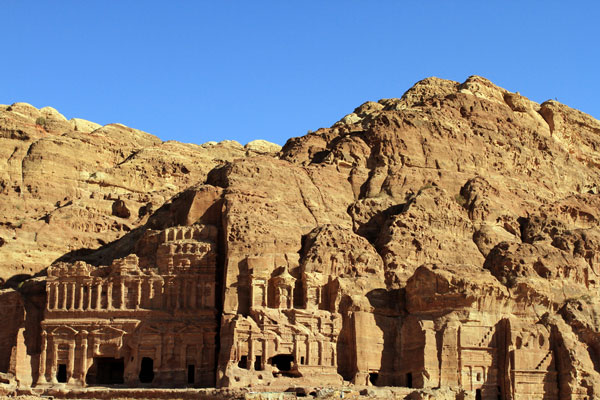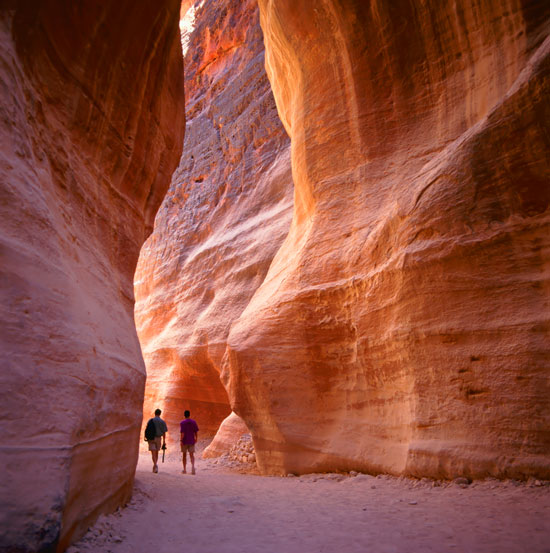Petra: The ancient city in the heart of the rock
The natural beauty and splendid ancient architecture of the city of Petra in Jordan attracts tourists from all over the world.
About 185km southwest of the Jordanian capital, Amman, Petra is an ancient city carved in stone. The natural beauty and splendid ancient architecture of the city attracts tourists from all over the world.
Petra gained more attention after some scenes of the movie 'Indiana Jones and the last crusade' were filmed here.

Temples, tombs and halls in Petra are scattered throughout 400 square miles.
Before being annexed by the Romans in 106 AD, Petra was the capital of the Nabataeans, a group of people who used Aramaic script and controlled trade groups through the region.
The tribe was first known in 312 BC when they survived the conquest of Antigonus, one of Alexander Dai's successors.
In these years, the Nabataeans were thought to have lived nomadic life and Petra was then perhaps the site of tents and simple structures.
The change took place when trade developed. Petra became the trade center between Saudi Arabia, Mesopotamia, Egypt and the eastern Mediterranean.
The prosperity of the city took place about 2000 years ago with residents projected at 20,000 people.
The Romans annexed this land and gradually gained the right to dominate the precious trade path. The city was devastated by a series of earthquakes and was eventually abandoned.

Siq, a narrow alley, is the path leading to the hidden city of Petra.
Johann Ludwig Burckhardt discovered the city in 1812 and today Petra is one of the main tourist attractions.
In the plot of the movie 'Indiana Jones and the final crusade' , Petra is placed in the 'crescent moon canyon' and the land of the Holy Grail.
Houses and water sources
Analysis of residual houses in ez-Zantur in Petra shows that the houses were carved in stone about 2,100 years ago, beginning the period of urbanization when people left camps to live in house carved in stone.
The main street of Petra, now known as the road with columns, was built in the south of Wadi Musa town. The walls were built north and south of the town, combined with the quarries in Petra to turn the city into a hard-to-invade place.
A sophisticated water pumping system has also been built with channels, pipes and tanks to bring water to the people. Recently, archaeologists have found evidence of this system in a physiological survey in the vicinity of Petra's main street.
However, these developments are now overshadowed by the city's tomb and temple architecture.
'Treasure'
Petra contains numerous tombs, most of which are built on the edge of the city, above the main street. Some tombs are simply designed, containing a lot of burial pits in an unremarkable stone tomb, while others are sophisticatedly designed.
Petra's most famous tomb is Khazneh, Arabic which means 'Treasure' . Called so because the locals once believed that the tomb contained secret treasures. Today, archaeologists call it a two-story high tomb. The size of money is measured with a height of 39 meters and a width of 25 meters.

Khazneh, or Treasure is a splendid tomb at Petra.
Designed primarily in Greek structure, the columns were built in Corin style, the vertical walkway with pictures depicting two legendary twin brothers Castor and Pollux.
Above the center is a woman who can be a simulated image of Isis, an Egyptian god. Also shown is the image of six legendary female warriors in the ancient world.
Illustrated images also include bird-headed, eagle-eagle monsters, two winged animals that are considered symbols of victory and images of plants such as poppies, grapes and pomegranates. The rose, the royal symbol is also shown here, indicating that this is the grave of a king.
Inside the tomb is designed quite simply with a corridor leading to three rooms, the largest room in the center with 12.5 meters long, 11 meters wide and about 10 meters high. Three rooms showed that there were three coffins in the past.
There is no description of who was buried in the grave and exactly when it was built. Researcher Andrew Stewer in the book 'Discover Petra' says that it may be the grave of King Aretas IV, died in 15 AD and has two wives.
Ancient temples
The ancient inhabitants of Petra maintained a rich religious life. It is believed that the three temples are located near the main road built during the city's prosperity about 2000 years ago.
One of them is Oasr al-Bind. The temple wall is still preserved with a height of 23 meters. A person will have to climb 19 steps up to the stop then 8 more steps through 4 columns to reach the temple corridor before going to a main hall with the size of each side of the hall about 28 meters. At the end is the Most Holy Place. The image depicted in the temple shows that this structure can be built for the god Dushara.

The image depicted in the temple shows that this structure can be built for the god Dushara.
Another structure called "Big Temple" by archaeologists, contains a small hall with the same design as an existing symphony room. Big enough to accommodate 600 people, this hall could be used for religious ceremonies. Among the temple motifs are images of elephant heads carved on limestone.
The third temple, partially placed on a hill, is a temple of winged lions. Called so by images of animals with these wings found near the altar.
The temple itself is quite small in size. However, as researcher Phillip Hammond points out in the book 'Discover Petra' , the temple has a lot of support buildings, 'is the residence of temple staff, pilgrims waiting to be in the temple, oil and metal production areas, service equipment and even production of antique imitation items for tourists! '.
- The whole city is an astronomical calendar
- Petra old city (Jordanie)
- Found ancient Mayan city in Mexican forest
- Compare 7 world wonders in ancient and modern times
- 10 ancient cities have disappeared completely from the world map
- 10 legendary ancient legends to this day
- Fans are excited to discover the ancient gods on Mars
- 2,000-year-old city trace in Egypt
- The ancient city suddenly
- Discovering the ancient city disappeared 2000 years ago
- Discovered the old city of 3400 years old in Israel
- Ancient cities thought only in legend
 'Fine laughs' - Scary and painful torture in ancient times
'Fine laughs' - Scary and painful torture in ancient times The sequence of numbers 142857 of the Egyptian pyramids is known as the strangest number in the world - Why?
The sequence of numbers 142857 of the Egyptian pyramids is known as the strangest number in the world - Why? History of the iron
History of the iron What is alum?
What is alum? Development of a robot that can dig through the hardest rock
Development of a robot that can dig through the hardest rock  Discover the ancient 'technical wonders' that provide 45 million liters of water in the desert
Discover the ancient 'technical wonders' that provide 45 million liters of water in the desert  The whole city is an astronomical calendar
The whole city is an astronomical calendar  Found blue diamonds in South Africa
Found blue diamonds in South Africa  Highway replica hanging garden Babylon nearly intact after 2000 years
Highway replica hanging garden Babylon nearly intact after 2000 years  Petra old city (Jordanie)
Petra old city (Jordanie) 